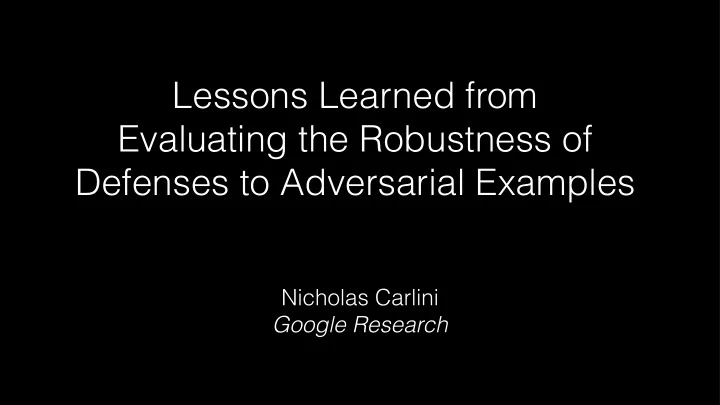

Lessons Learned from Evaluating the Robustness of Defenses to Adversarial Examples Nicholas Carlini Google Research
Lessons Learned from Evaluating the Robustness of Defenses to Adversarial Examples
Lessons Learned from Evaluating the Robustness of Defenses to Adversarial Examples
Why should we care about adversarial examples? Make ML Make ML robust better
How do we generate adversarial examples?
Random Direction Truck Random Direction Dog
Random Random Direction Direction Truck Adversarial Adversarial Direction Direction Dog Airplane
( (
Lessons Learned from Evaluating the Robustness of Defenses to Adversarial Examples
A defense is a neural network that 1. Is accurate on the test data 2. Resists adversarial examples
For example: Adversarial Training Claim: Neural networks don't generalize Madry, A., Makelov, A., Schmidt, L., Tsipras, D., & Vladu, A. Towards deep learning models resistant to adversarial attacks. ICLR 2018
Normal Training ( , ) 7 F Training ( , ) 3
Adversarial Training (1) ( , ) 7 Attack ( , ) 3 ( , ) 7 ( , ) 3
Adversarial Training (2) ( , ) 7 G Training ( , ) 3 ( , ) 7 ( , ) 3
Or: Thermometer Encoding Claim: Neural networks are "overly linear" Buckman, J., Roy, A., Raffel, C., & Goodfellow, I. Thermometer encoding: One hot way to resist adversarial examples. ICLR 2018
Solution T(0.13) = 1 1 0 0 0 0 0 0 0 0 T(0.66) = 1 1 1 1 1 1 0 0 0 0 T(0.97) = 1 1 1 1 1 1 1 1 1 1
Or: Input Transformations Claim: Perturbations are brittle Guo, C., Rana, M., Cisse, M., & Van Der Maaten, L. Countering adversarial images using input transformations. ICLR 2018
Solution Random Transform
Solution JPEG Compress
Lessons Learned from Evaluating the Robustness of Defenses to Adversarial Examples
What does it meant to evaluate the robustness of a defense?
Standard ML Pipeline model = train_model(x_train, y_train) acc, loss = model.evaluate( x_test, y_test) if acc > 0.96: print("State-of-the-art") else: print("Keep Tuning Hyperparameters")
Standard ML Pipeline model = train_model(x_train, y_train) acc, loss = model.evaluate( x_test, y_test) if acc > 0.96: print("State-of-the-art") else: print("Keep Tuning Hyperparameters")
Standard ML Pipeline model = train_model(x_train, y_train) acc, loss = model.evaluate( x_test, y_test) if acc > 0.96: print("State-of-the-art") else: print("Keep Tuning Hyperparameters")
Standard ML Evaluations model = train_model(x_train, y_train) acc, loss = model.evaluate( x_test, y_test) if acc > 0.96: print("State-of-the-art") else: print("Keep Tuning Hyperparameters")
Standard ML Evaluations model = train_model(x_train, y_train) acc, loss = model.evaluate( x_test, y_test ) if acc > 0.96: print("State-of-the-art") else: print("Keep Tuning Hyperparameters")
What are robustness evaluations?
Standard ML Evaluations model = train_model(x_train, y_train) acc, loss = model.evaluate( x_test, y_test) if acc > 0.96: print("State-of-the-art") else: print("Keep Tuning Hyperparameters")
Adversarial ML Evaluations model = train_model(x_train, y_train) acc, loss = model.evaluate( A( x_test, model ) , y_test) if acc > 0.96: print("State-of-the-art") else: print("Keep Tuning Hyperparameters")
How complete are evaluations?
Case Study: ICLR 2018
Serious effort to evaluate By space, most papers are ½ evaluation
We re-evalauted these defenses ...
2 Out of scope 4 Broken Defenses Correct Defenses 7
2 Out of scope 4 Broken Defenses Correct Defenses 7
2 Out of scope 4 Broken Defenses Correct Defenses 7
So what did defenses do?
Lessons Learned from Evaluating the Robustness of Defenses to Adversarial Examples
Lessons (1 of 3) what types of defenses are effective
First class of effective defenses:
First class of effective defenses: Adversarial Training
Second class of effective defenses:
Second class of effective defenses: _______________
Lessons (2 of 3) what we've learned from evaluations
So how to attack it?
"Fixing" Gradient Descent [0.1, 0.3, 0.0, 0.2, 0.4]
Lessons (3 of 3) performing better evaluations
Actionable advice requires specific, concrete examples Everything the following papers do is standard practice
Perform an adaptive attack
A "hold out" set is not an adaptive attack
Stop using FGSM (exclusively)
Use more than 100 (or 1000?) iteration of gradient descent
Iterative attacks should always do better than single step attacks.
Unbounded optimization attacks should eventually reach in 0% accuracy
Unbounded optimization attacks should eventually reach in 0% accuracy
Unbounded optimization attacks should eventually reach in 0% accuracy
Model accuracy should be monotonically decreasing
Model accuracy should be monotonically decreasing
✓
Evaluate against the worst attack
Plot accuracy vs distortion
Verify enough iterations of gradient descent
Try gradient-free attack algorithms
Try random noise
The Future
The Year is 1997
Recommend
More recommend